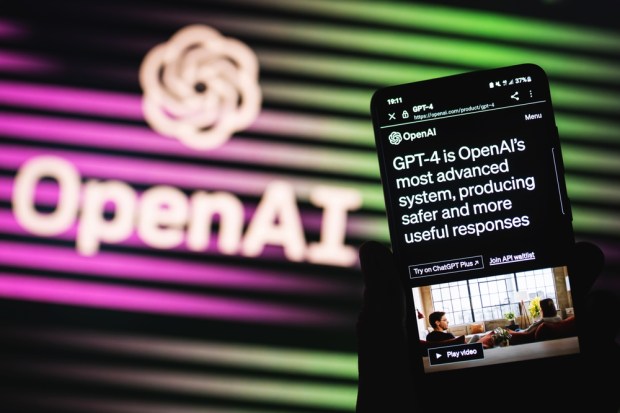A Tale of Two GPTs

Except perhaps for those who have been completely off the grid for the last year, pretty much everyone has heard about ChatGPT.
That’s the AI application that has convinced the world — including the long-overpromising and underdelivering artificial intelligence profession — that AI really is what it has been cracked up to be. OpenAI said its conversational chatbot can “answer follow-up questions, admit its mistakes, challenge incorrect premises, and reject inappropriate requests.” Just like a human, except a lot more knowledgeable and much faster.
The authors of that statement were too modest. It turns out that ChatGPT can spit out a crisply worded essay on just about anything. Yes, it hallucinates — it may just make stuff up — and needs a watchful editor, but then again, so do some human writers after ingesting a bit too much cannabis. GPT stands for “Generative Pre-trained Transformer.” That’s a type of AI model that has learned so much from being fed massive amounts of text data that it can spit out novel content — just like humans do.
Economists have a “GPT” model, too, but weren’t clever enough to get a trademark on the acronym. A classic 1995 paper by Tim Bresnahan and Manuel Trajtenberg introduced the notion of “General Purpose Technologies,” which economists call GPTs. In the economists’ version, GPTs are used as inputs into many other technologies, which GPTs can improve a lot and increase the returns to R&D in many parts of the economy. Lots of innovations, and the technologies they spawn, aren’t GPTs. They may be important, like MP3 or indoor plumbing, but limited in scope. General Purpose Technologies are technologies such as electricity, chips, and internal combustion engines that beget waves of innovation, productivity gains, and new products throughout the economy and over time. GPTs are the gift that keeps on giving.
The economics of General Purpose Technologies provide insights into the evolution of new technologies including those being introduced by AI.
Economists have learned that most innovations take a long time to get widely adopted. They have to get perfected, incorporated in products or processes, and adopted by people and businesses. Businesses may be slow to adopt them because they are unsure of the value, would have to rip out existing equipment or change practices, or just because of inertia — being settled in their ways. It took about 20 years for even half of the manufacturing plants to adopt the electric motor and another 20 to reach 80 percent. The digital economy hasn’t been so fast either. It took 16 years after the launch of the commercial internet (1995) for eCommerce to account for 5 percent of retail sales (2011) and 25 years to account for 10 percent (2019) in the U.S.
General Purpose Technologies involve sequential waves of innovation, each of which takes time to diffuse through the economy. Electric power has been chugging along for almost 150 years and will probably continue to do so. Microchips have, too, for more than 60 years. And now provide the brains for a vast array of products beyond their original application to computers. An average American car has more than 1,000. GPTs also make other GPTs possible. Without chips, we wouldn’t have mobile devices such as smartphones. Nor would we have AI, which requires computers that do massive numbers of operations a second to learn enough to be smart enough.
Let’s return to ChatGPT. While Generative Pre-trained Transformers could be a general-purpose technology in their own right, importantly, what’s important about ChatGPT is that it demonstrates that AI will become an extremely powerful technology more generally. There were doubts about this. AI showed early promise in beating humans at well-defined tasks such as playing chess or diagnosing medical ailments. It turned out to be much harder than experts thought to scale the technology to solve problems that involved understanding context and dealing with ambiguity—the sorts of things that even young kids can do. Based on what we know AI will be a General Purpose Technology.
ChatGPT, and other large language learning models that are being perfected, show that AI technologies, combined with vast amounts of data, and enormous computing power will likely be able equal or excel humans at many tasks and do things that no human could even contemplate doing.
The early work on AI was done in the mid 1940s. In 1957, Herbert Simon, an important contributor, famously predicted that “in a visible future … the range of problems [AI] can handle will be coextensive with the range to which the human mind has been applied.” Even though ChatGPT has taken off very quickly and is being incorporated into a variety of products, we should recognize that it will take time to work out the kinks, for other applications of AI to reach a similar inflection point, and for AI-powered new products and services that we can’t envision today being introduced.
There are two important features of AI models that indicate that AI will likely diffuse far more quickly and broadly than traditional General Purpose Technologies such as electricity. These models are based on software and digital data. Once developed, AI-based models can be made available everywhere through the internet. The marginal cost of using an AI-based model is mainly the computational costs; while these aren’t trivial today, they will decline dramatically over time. Moreover, Generative Pre-trained Transformers and other large language models can be made available as multisided platforms which support apps. We are already seeing an app ecosystem developing around the Open AI open-source platform and the proprietary ChatGPT. The platform model can unleash rapid global innovation, as we saw with iOS and Android. AI can thereby provide an incredibly powerful accelerant for digital transformation.
As just a substitute for, and magnifier of, human intelligence that can be embedded in products and services and applied at scale globally, it is obvious that AI is a General Purpose Technology that will lead to waves of innovation for decades, if not centuries, to come. That is likely to be true even if concerns over AI’s impact on society limited its uses to where its social benefits far outweigh the risks of harm.
David S. Evans is an economist who has published several books and many articles on the technology businesses, including digital and multisided platforms, including the award-winning Matchmakers: The New Economics of Multisided Platforms. He is currently the Global Leader for Digital Economy and Platform Markets at Berkeley Research Group. For more details on him, go to davidsevans.org.

